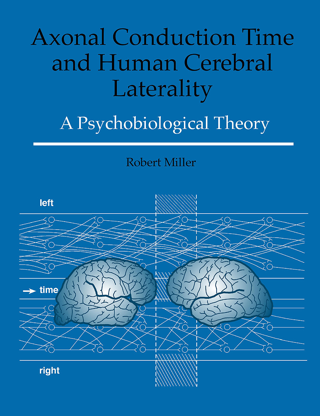Axonal Conduction Time and Human Cerebral Laterality – A Psychobiological Theory
(Robert Miller; Harwood Academic Publishers; 310 pages, including subject and author indices.)
This work was originally published in 1996, by Harwood Academic Publishers, and is still in print. It develops a theory of the normal functional differences between left and right hemispheres, based on a simple premise about conduction time in cortico-cortical axons: It is postulated that, in the right hemisphere, conduction times tend to be short, while in the left they are longer, constituting a “repertoire of delay linesâ€. This “central hypothesis†has some support from biological measures (such as brain morphology, electrophysiology), but much of the book is devoted to showing how, with this assumption, a wide range of psychological differences between the two hemispheres can be explained – in the areas of perception, motor control, sustained attention, contents of memory etc. A section also deals with the correlations between these aspects of asymmetry. The “central hypothesis†for this work is closely related to that used in a much larger work, “A Neurodynamic theory of schizophrenia and related disorders†(Miller, 2008; details on this website). The work on normal cerebral asymmetry was undertaken in the early 1990s specifically because a prerequisite for any theory explaining schizophrenia as an abnormal variant of cerebral asymmetry has to start from an adequate theory of normal asymmetry. “Axonal Conduction Time and Human Cerebral Laterality†is still available, and can now be obtained from Taylor and Francis/CRC Press, or from Amazon.com (price new: $169.95; used and new: from $104).
